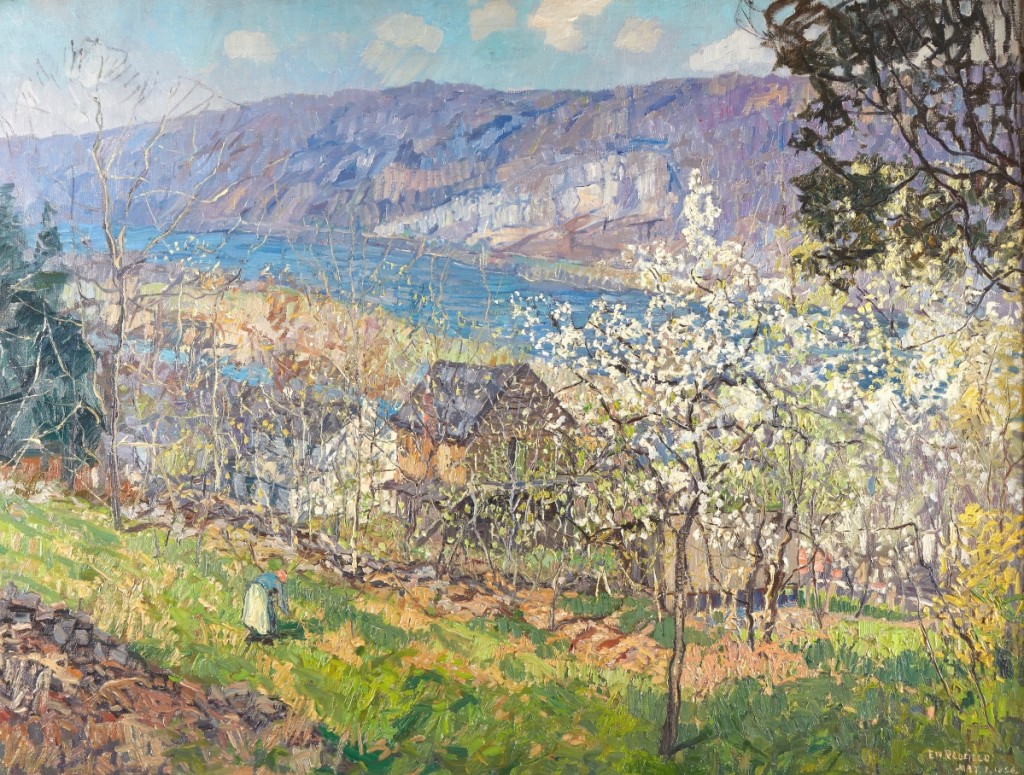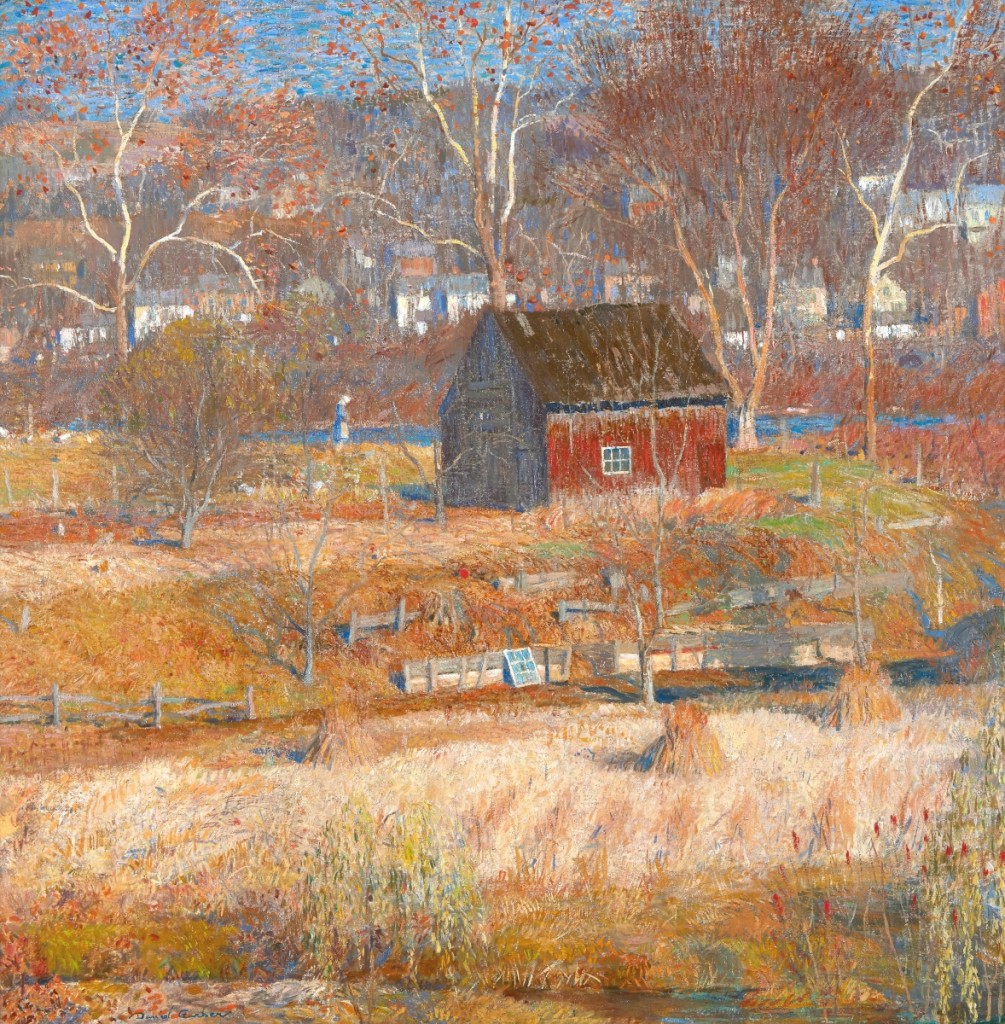
Six phone bidders competed for the sale’s top lot, “Spring at Point Pleasant on the Delaware River” by Edward Willis Redfield, 1926, oil on canvas, 38 by 50 inches. It sold to a private collector, who had never bought at Freeman’s before, for $483,000 ($300/500,000).
Review by Madelia Hickman Ring, Catalog Photos Courtesy Freeman’s
PHILADELPHIA – Freeman’s sale of American Art & Pennsylvania Impressionists on Sunday, June 14, offered 74 lots, and with all but four selling, was 95 percent sold and totaled $2,852,102 against an aggregate estimate of $1,715,500/2,667,000. The pandemic resulted in a slightly smaller sale than usual – Freeman’s typically fields 100-120 lots – but the sale otherwise offered a balanced mix of subjects across a broad range of price points. Following the firm’s conventional pattern, American art was offered in the first half of the auction, with works by Pennsylvania Impressionists filling out the second half. According to Alasdair Nichol, Freeman’s chairman and head of fine art, the sale was split about 50-50, between American art and Pennsylvania Impressionists, with the latter part of the sale being 100 percent sold.
“Selling to a room absent any members of the public was an interesting experience,” Nichol told Antiques and The Arts Weekly by phone the day after the sale. “All the bidding via phone and internet was conducted by our saleroom staff – all socially distanced – who were in an ebullient mood, which matched the exuberant bidding. It felt very much like selling during a market peak rather than in the midst of a pandemic. We are delighted with the results – as are our clients going by the messages and calls we received after. The sale far exceeded our wildest expectations, particularly given the extraordinary circumstances. Altogether very positive and encouraging. I believe we have entered a new era for how auctions will be conducted in the future.”
Freeman’s has begun to move away from printed catalogs, relying more heavily on digital photography that can be more actively engaged, including the ability to zoom in for details, to see artworks out of the frame, to rotate objects 360 degrees or access to documents and related material. The firm had first used that technology in its Modern and Contemporary Art sale in mid-May, but this was the first sale of American Art and Pennsylvania Impressionists in which it had been rolled out; Nichol said it was very well received, characterizing it as “a new era for us,” attributing its success to an increased confidence people have in bidding and buying online.
Anchored by 11 lots from the “ready to hang” Florida collection of Heidi Bingham Stott, which was 100 percent sold and realized a total of $1,354,875, the Pennsylvania Impressionists section with its local appeal yielded the stronger results for the sale. When asked what trends he is seeing in the field, Nichol said he was encouraged to see new and sometimes younger buyers in several price ranges, suggesting both longevity and depth.
 The top lot of the sale – “Spring at Point Pleasant on the Delaware River” by Edward Willis Redfield (American, 1869-1965) – realized $483,000 against an estimate of $300/500,000. “It was an ‘A-plus’ example, one of the best to come to market in years,” Nichol said of the work, which the catalog described as one of the artist’s largest compositions that captured all the hallmarks of Redfield’s style and one of his favorite subjects. He said it sold to a new buyer bidding on the phone.
The top lot of the sale – “Spring at Point Pleasant on the Delaware River” by Edward Willis Redfield (American, 1869-1965) – realized $483,000 against an estimate of $300/500,000. “It was an ‘A-plus’ example, one of the best to come to market in years,” Nichol said of the work, which the catalog described as one of the artist’s largest compositions that captured all the hallmarks of Redfield’s style and one of his favorite subjects. He said it sold to a new buyer bidding on the phone.
The sale offered four other works by Redfield, which Nichol said was the first time Freeman’s had offered so many at one time, stressing that each had differences about them so that they did not compete against each other. Redfield’s “May, Point Pleasant” attracted more attention than any example by the artist and sold for $225,000 to another new buyer who had also competed for the top lot. The same price was paid for “The Peaceful Valley,” a work from 1930, the peak of the artist’s career. It is considered one of the artist’s boldest and most modern depictions of spring. His “Blue Ridge Mountain, Shawnee, Pennsylvania,” also done in 1930, realized $112,500, while an early work, done around 1899, titled “Cedar Trees Along a Pathway,” made $30,000.
Daniel Garber (American, 1880-1958) was represented with three works, including “Rodger’s Meadow,” which a trade buyer bidding on behalf of a client took for $312,500, the second highest price in the sale. The 1920s are considered a period of “relaxed maturity” for the artist, who gradually moved away from his large decorative compositions to focus on smaller works such as “Rodger’s Meadow.” Garber’s “September Morning” uses pastel-like and colorful tones typical of his compositions from the late 1930s. The work is devoid of any human presence – automobiles, telephone and electric poles – and speaks to the artist’s fascination for a simple, secluded way of life. It made $112,500. The last of his works on offer – “Autumn Solebury” – is a later work done in 1949 and doubled its high estimate to bring $100,000.
Freeman’s set two artist records in the auction. Receiving the most interest of any painting in the sale and pursued by 13 phone bidders, “The Bonfire” by William Langson Lathrop (American, 1859-1938), realized $112,500. Jackson Lee Nesbitt’s (American, 1913-2008) “November Evening,” also set a new record for the artist, bringing more than ten times its low estimate to sell for $52,000 to a private collector who prevailed against a trade bidder.
Works by the Wyeth family are perennial favorites at Freeman’s and this sale did not disappoint, bringing $75,000 for “The Converted Barn” by Newell Convers Wyeth (American, 1882-1945). The work predates his illustration work, the landscapes Wyeth produced prior to 1910 reveal a taste for independence and recognition. “The Converted Barn” was painted in 1908, the same year the artist moved to Chadds Ford, Penn.

A trade buyer, bidding on the phone on behalf of a private collector, paid the second highest price in the sale, acquiring “Rodger’s Meadow” by Daniel Garber (America, 1880-1958) for $312,500. The work was one of about 20 paintings Garber presented in his second solo exhibition at Macbeth Gallery in New York in 1925, where it was appreciated by critics and reviewers ($200/300,000).
Fern Isabel Coppedge (American, 1883-1951) is also a regularly featured artist, with four works in the sale, including one from the brief period of time she spent in Italy. “Florentine Gold,” painted in 1926, brought $62,500 from a private collector outside of Pennsylvania. Two of Coppedge’s works of Gloucester, Mass., each exceeded their high estimates, with “Tidewater Glow, Gloucester” bringing $65,000 and “Gloucester Harbor” making $50,000. Her “Spring by the Delaware River” realized $32,500.
Additional highlights from the American art portion of the sale included “Vermont Hillside” by Theodore Robinson (American, 1851-1896), which sold for $43,750 and $40,625 for “Le Train à Giverny” by Theodore Earl Butler (American, 1861-1936). A historical genre scene by Edwin White (American, 1817-1877) depicting the signing of the Mayflower compact achieved $32,500, while a portrait of Katherine Cecil Sanford by Robert Henri (American, 1865-1929) brought $25,000.
Freeman’s next sale of American art and works by Pennsylvania Impressionists will take place in December.
Prices quoted include the buyer’s premium as reported by the auction house.
For additional information, www.freemansauction.com.























